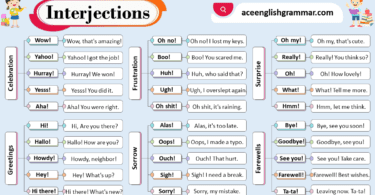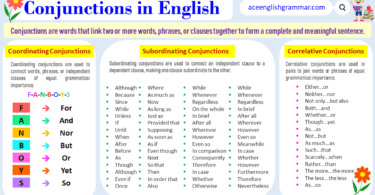Understanding the types of nouns is essential for mastering English grammar. Nouns are the building blocks of sentences, representing people, places, things, and ideas. However, many learners struggle to identify different types like common, proper, abstract, and collective nouns. This blog post helps learn types of nouns with clear explanations, rules, and examples to improve writing and speaking skills.
Table of Contents
What are Nouns?
A noun is a word that names a person, place, thing, or idea. It is one of the most important parts of speech in English.
Examples:
- Person: Ayesha, teacher, doctor
- Place: Mecca, school, park
- Thing: Book, chair, phone
- Idea: Honesty, love, happiness
Nouns play a crucial role in constructing sentences and expressing thoughts. They can serve as the subject, object, or complement in a sentence. For instance, in the sentence “The cat (noun) sat on the mat (noun).” “cat” is the subject, and “mat” is the object.
Types of Nouns
Common Nouns
Common nouns are general names for people, places, things, or ideas. They are not specific and do not begin with a capital letter unless at the beginning of a sentence.
Examples:
- Person: teacher, student
- Place: city, school
- Thing: book, table
Proper Nouns
Proper nouns, on the other hand, are specific and unique. They always begin with a capital letter, designating particular individuals, places, or things.
Examples:
- Person: John, Mary
- Place: Paris, Mount Everest
- Thing: Mona Lisa, iPhone
Concrete Nouns
Concrete nouns are tangible and represent things that can be perceived through the senses. They bring our world to life.
Examples:
- Person: baby, musician
- Place: beach, bakery
- Thing: puppy, chocolate
Abstract Nouns
Abstract nouns, in contrast, represent concepts, feelings, or qualities that can’t be touched or seen. Examples include “love,” “happiness,” and “freedom.”
Examples:
- Idea: freedom, courage
- Emotion: love, happiness
- Concept: democracy, justice
Countable Nouns
Countable nouns can be quantified as individual units, and they can take both singular and plural forms.
Examples:
- Singular: apple, car
- Plural: apples, cars
Uncountable Nouns
Uncountable nouns, also known as mass nouns, represent things that cannot be counted as separate units.
Examples:
- Uncountable: water, happiness
Collective Nouns
Collective nouns refer to groups of people, animals, or things. They can be singular or plural depending on whether the emphasis is on the group as a whole or its individual members.
Examples:
- People: team, family
- Animals: herd, flock
- Things: bunch, collection
Compound Nouns
Compound nouns are formed by combining two or more words to create a new noun. Examples include “toothpaste,” “sunflower,” and “breakfast.”
Examples:
- Noun + Noun: toothpaste, basketball
- Adjective + Noun: blackboard, blueberry
Possessive Nouns
Possessive nouns show ownership or possession. They are often formed by adding an apostrophe and “s” (‘s) to the end of a noun. Examples include “Sarah’s car” and “the cat’s tail.”
Examples:
- Singular Possessive: cat’s tail, girl’s book
- Plural Possessive: cats’ tails, girls’ books
Relative Nouns
Relative nouns introduce relative clauses in sentences and help connect ideas. Examples include “who,” “whom,” “whose,” “which,” and “that.”
Examples:
- Who: The girl who sings well.
- Which: The book which I bought yesterday.
- That: The car that is parked outside.
Indefinite Nouns
Indefinite nouns refer to non-specific people or things and are often used with words like “some” or “any.”
Examples:
- Somebody called while you were out.
- I don’t have any specific plans for the weekend.
Gerunds
Gerunds are verbs ending in -ing that function as nouns, representing activities or actions.
Examples:
- Swimming is my favorite sport.
- I enjoy reading before bedtime.
Appositive Nouns
- Definition: Nouns that provide extra information about another noun and are often set off by commas.
- Examples: My friend, a doctor, is visiting.
Functions of Nouns in Sentences
1. Subject
A subject is the noun that performs the action in a sentence. It tells us who or what the sentence is about.
Examples:
- Hamza plays football every evening.
- The cat sleeps on the sofa.
2. Object
An object is the noun that receives the action in a sentence. It comes after the verb and tells who or what is affected by the action.
Examples:
- She reads a book before bed.
- They bought a new car yesterday.
3. Possession
A possessive noun shows ownership or belonging. It is usually formed by adding an apostrophe (’s) to the noun.
Examples:
- This is Ali’s car.
- The teacher’s bag is on the table.
4. After a Preposition
Nouns often appear after prepositions in a phrase. This tells us more about location, time, direction, or reason.
Examples:
- She is sitting on the chair.
- The book is under the table.
Example Sentences of Nouns
- Ayesha is reading a book.
- We visited Mecca last year.
- The boy is playing football.
- She bought a new car.
- Her happiness was visible on her face.
- Honesty is the best policy.
- I placed the phone on the table.
- The dog is barking loudly.
- A team of players won the match.
- The herd of cattle is grazing in the field.
- I have three pencils in my bag.
- There are many books on the shelf.
- She poured some water into the glass.
- Knowledge is more valuable than money.
- A bird is sitting on the tree.
- The child is sleeping.
- The birds are flying in the sky.
- Children love playing outside.
- Ali’s car is very expensive.
- The teacher’s advice was helpful.
- He bought a notebook for school.
- My mother-in-law is visiting us.
- The stars are shining brightly.
- We enjoyed our vacation in Turkey.
- He gave me a beautiful gift.
- Common Mistakes in Using Nouns
Incorrect Singular and Plural Forms
❌ She bought two box.
✅ She bought two boxes.
Misuse of Countable and Uncountable Nouns
❌ I need informations about the event.
✅ I need information about the event.
Wrong Use of Possessive Nouns
❌ This is Ali car.
✅ This is Ali’s car.
Confusion Between Common and Proper Nouns
❌ I visited paris last year.
✅ I visited Paris last year.
Omitting Articles Before Nouns
❌ She adopted cat.
✅ She adopted a cat.
Redundant Use of Plural Forms
❌ I have many furnitures in my house.
✅ I have a lot of furniture in my house.
Using Nouns Instead of Pronouns
❌ Amina is my friend. Amina loves painting.
✅ Amina is my friend. She loves painting.
Avoiding these mistakes ensures clear, correct, and natural English communication.
Why Are Nouns Important in English?
Foundation of Sentences:
Nouns are the core elements of sentences, providing structure and meaning.
Help in Communication:
They allow us to name people, places, things, and ideas, making communication clear.
Provide Specificity:
Nouns give precise details about what or whom we are talking about.
Enable Possession and Relationship:
They help show ownership and connections between people or things.
Support Grammar Structure:
Nouns work with verbs, adjectives, and prepositions to form complete sentences.
Ensure Clarity and Coherence:
They make sentences more structured, ensuring effective communication in writing and speech.
FAQs
There are five main types of nouns in English: proper nouns, common nouns, abstract nouns, concrete nouns, and collective nouns. Each type serves a specific function in a sentence.
A proper noun is the specific name of a person, place, or thing. It always starts with a capital letter.
Example: Fatima lives in Istanbul.
A common noun is a general name for people, places, or things (e.g., city, boy), while a proper noun refers to a specific name (e.g., Lahore, Hamza).
Concrete nouns refer to physical objects that can be seen, touched, or measured (book, apple, chair).
Abstract nouns refer to ideas, emotions, or qualities that cannot be touched (love, bravery, happiness).
A collective noun is a word that represents a group of people, animals, or things as a single unit.
Example: A flock of birds.
Countable nouns can be counted (pen, car, apple).
Uncountable nouns cannot be counted individually (milk, sugar, knowledge).
A noun is usually a person, place, thing, or idea. It can be the subject or object of a sentence. You can check if an article (a, an, the) or an adjective can be placed before it.
A singular noun refers to one person, place, or thing (cat, book), while a plural noun refers to more than one (cats, books).
Possessive nouns show ownership or belonging by adding ’s or ‘ to a noun.
Example: Ayesha’s book is on the table.
Conclusion
Nouns are essential for constructing sentences because they help us identify and describe everything in the world. Understanding nouns and their types helps improve English grammar and communication skills.
Read More





Leave a Comment